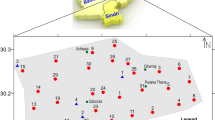Abstract.
Geochemical and geoelectrical investigations were carried out around a hot spring near village Singhpur, Nayagarh District of Orissa to delineate the extent of fluoride contamination in groundwater. Fluoride concentration is observed to be very high in both hot spring and groundwater of Singhpur village compared with surrounding ones. Vertical electrical sounding (VES) studies in the area reveal the presence of two to four prominent litho units. The weathered and fractured litho units constitute the main aquifer system. Spatial distribution of apparent resistivities at different electrode spacing indicates the presence of a low apparent resistivity zone encompassing the hot spring and the villages with fluoride contamination such as Singhpur and Sagaragan. Fluoride concentrations of groundwater and hot spring water show an inverse relation with the apparent resistivity of the formation at different electrode spacing. The results of geoelectric soundings, coupled with the geochemical studies and a well inventory, confirm that the fluoride contamination of groundwater is mainly due to venting of thermal water into the regional aquifer system through the fractured and weathered rocks.
Similar content being viewed by others
Author information
Authors and Affiliations
Additional information
Electronic Publication
Rights and permissions
About this article
Cite this article
Kundu, .N., Panigrahi, .M., Sharma, .S. et al. Delineation of fluoride contaminated groundwater around a hot spring in Nayagarh, Orissa, India using geochemical and resistivity studies. Env Geol 43, 228–235 (2002). https://doi.org/10.1007/s00254-002-0651-7
Received:
Accepted:
Issue Date:
DOI: https://doi.org/10.1007/s00254-002-0651-7




